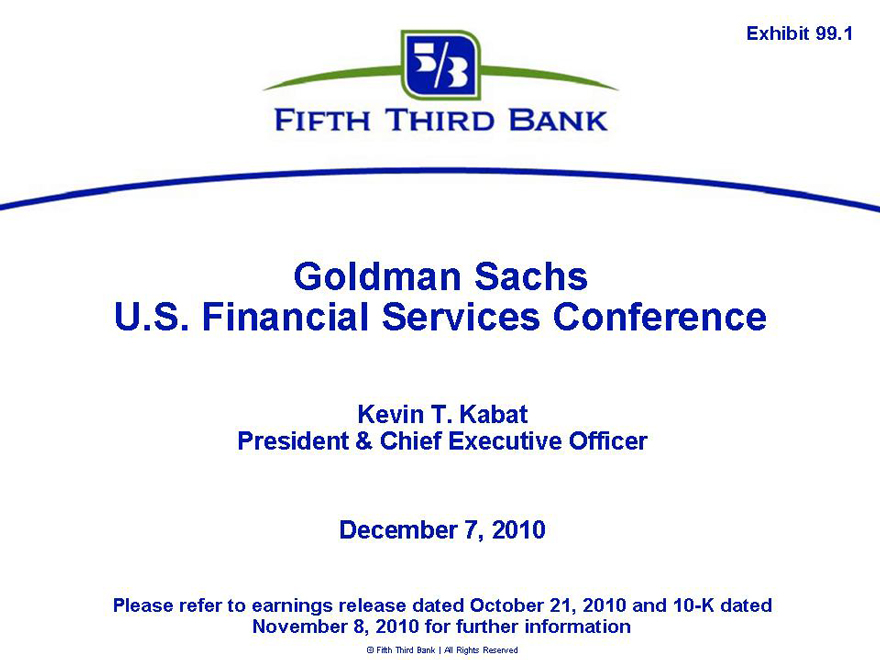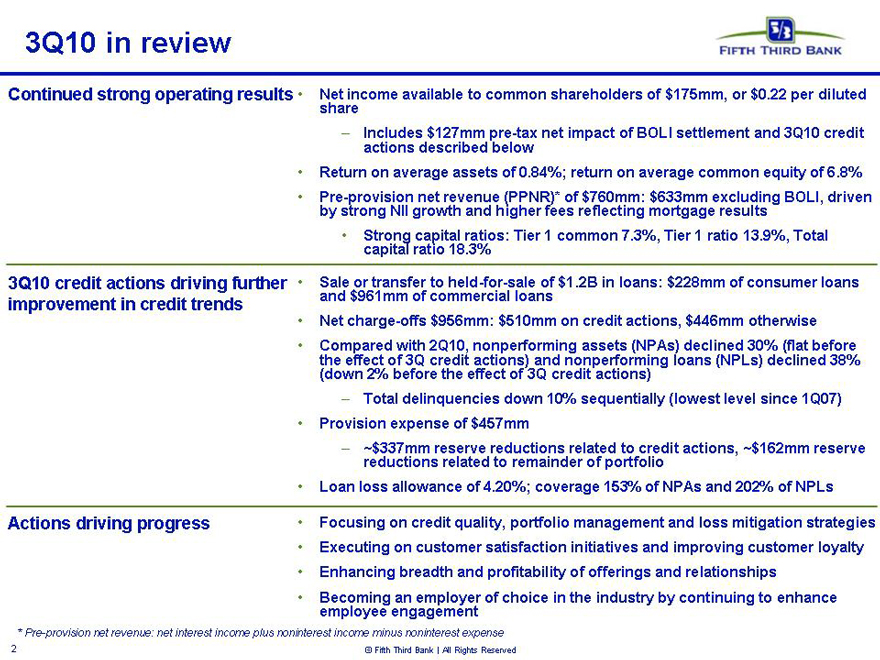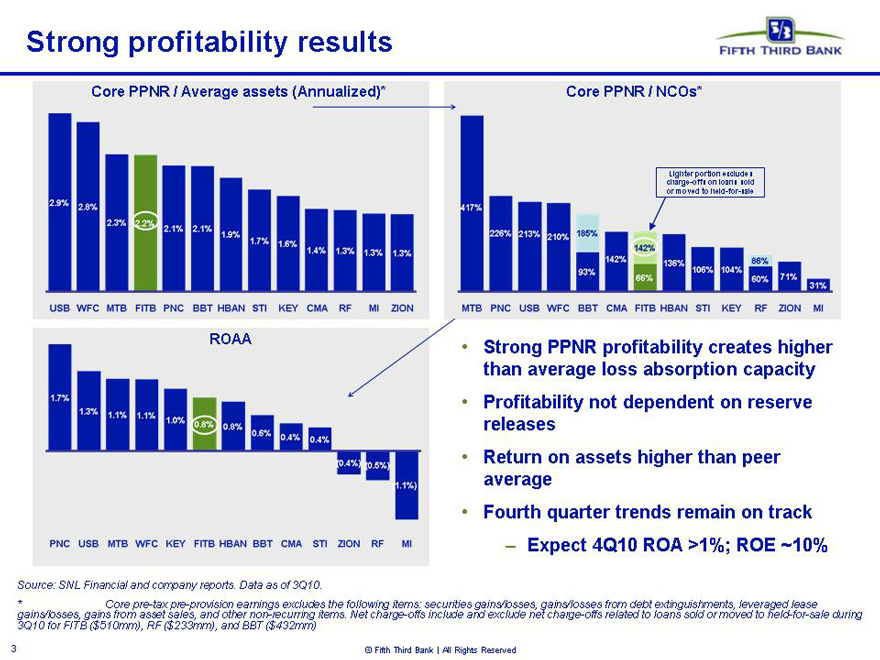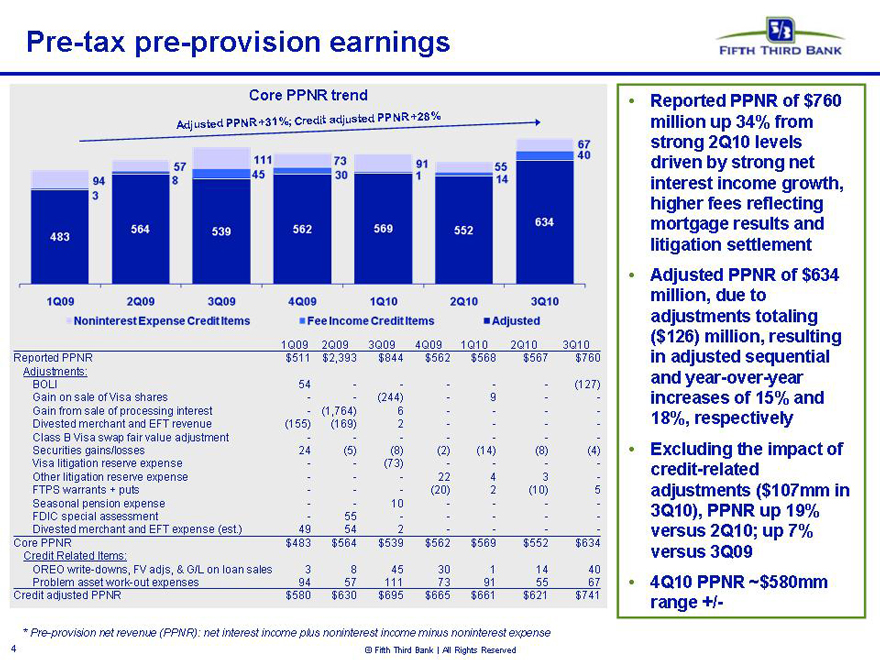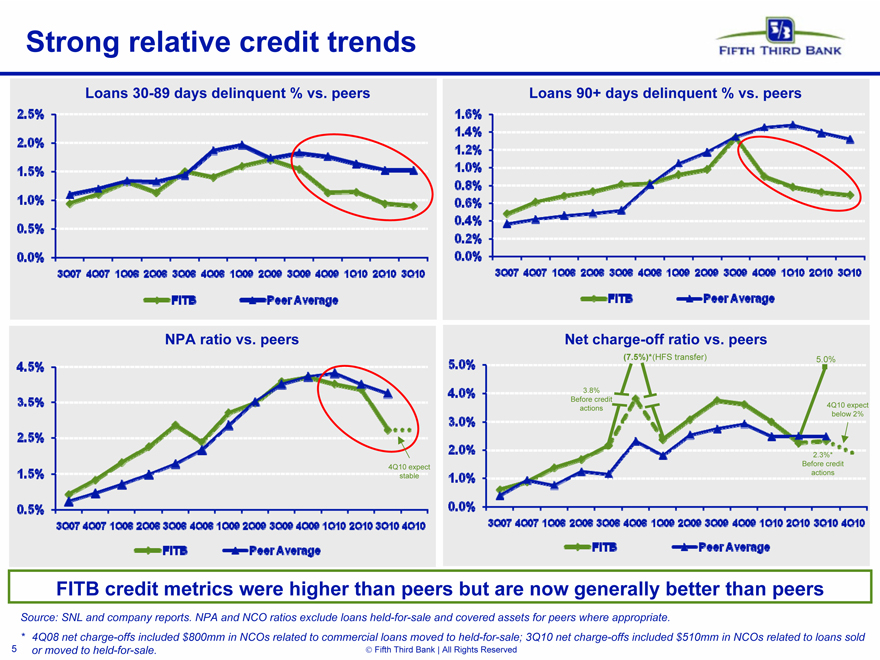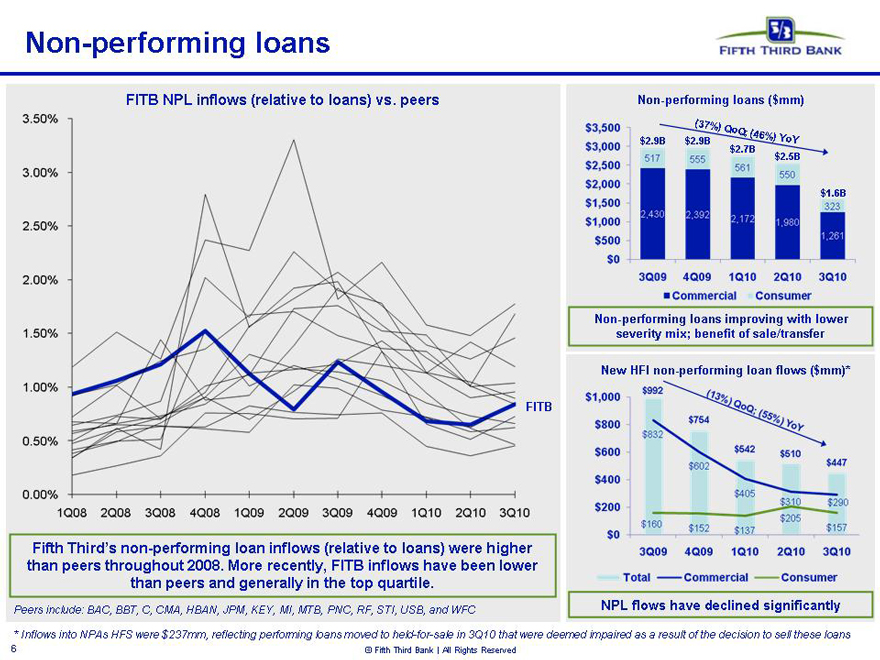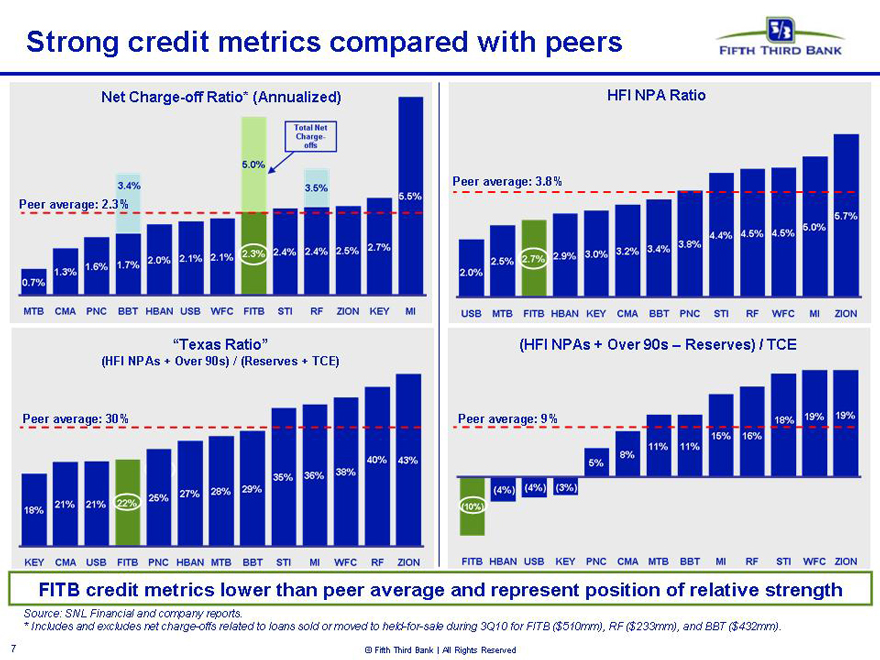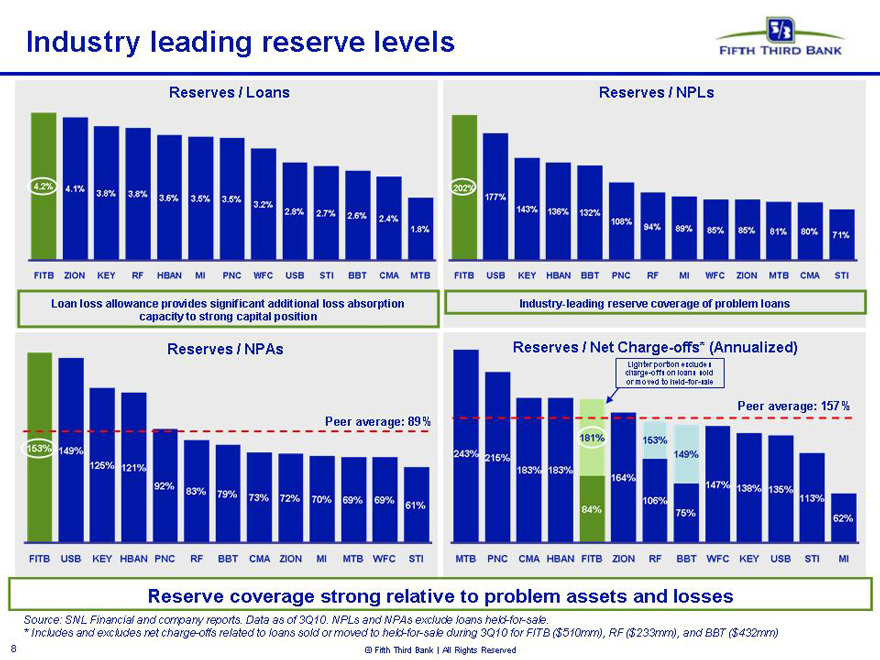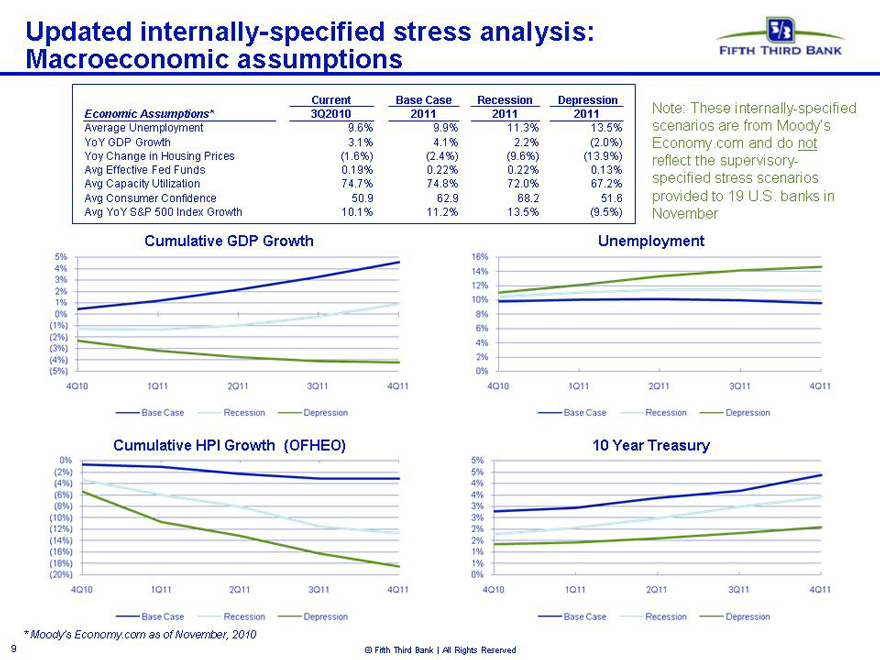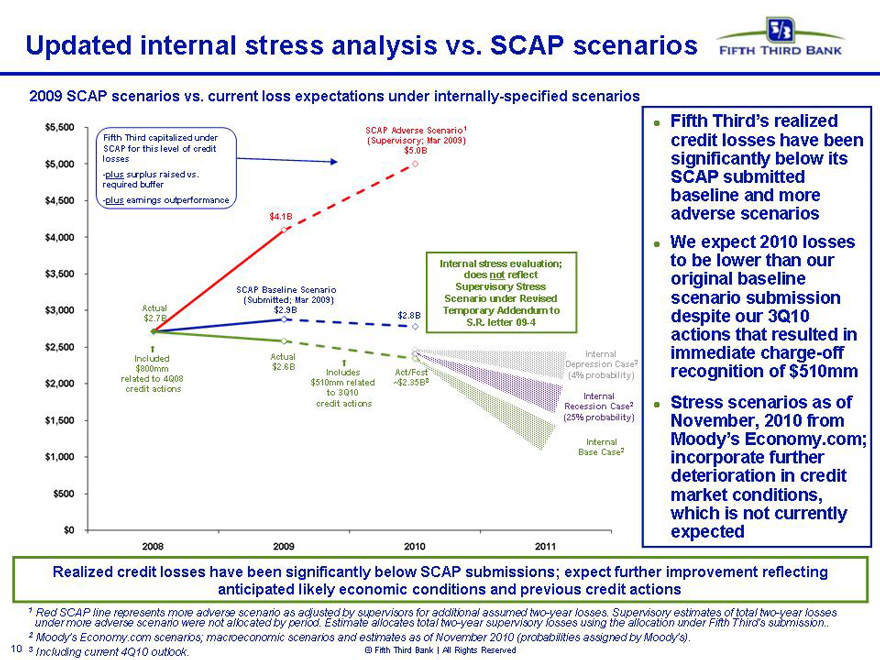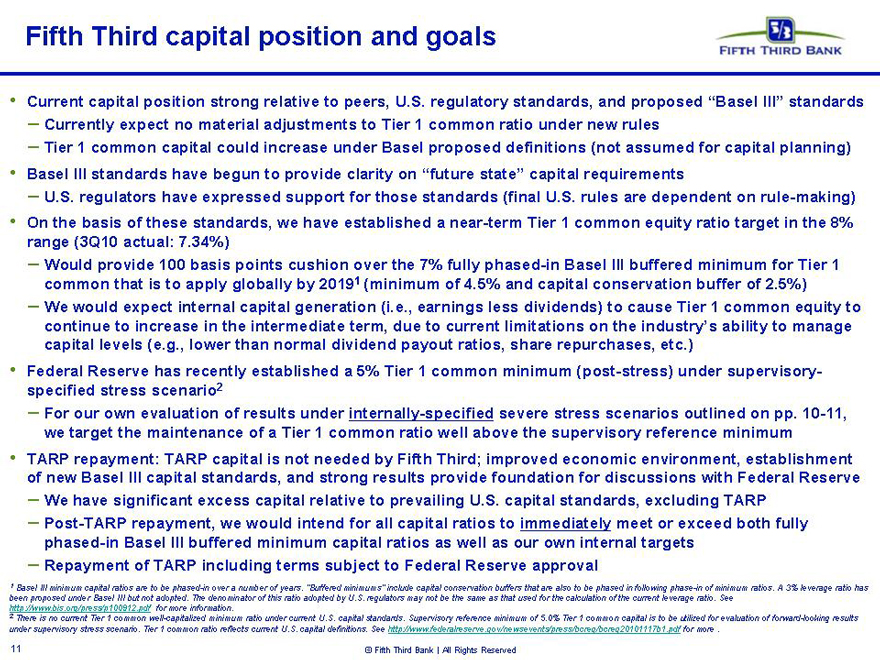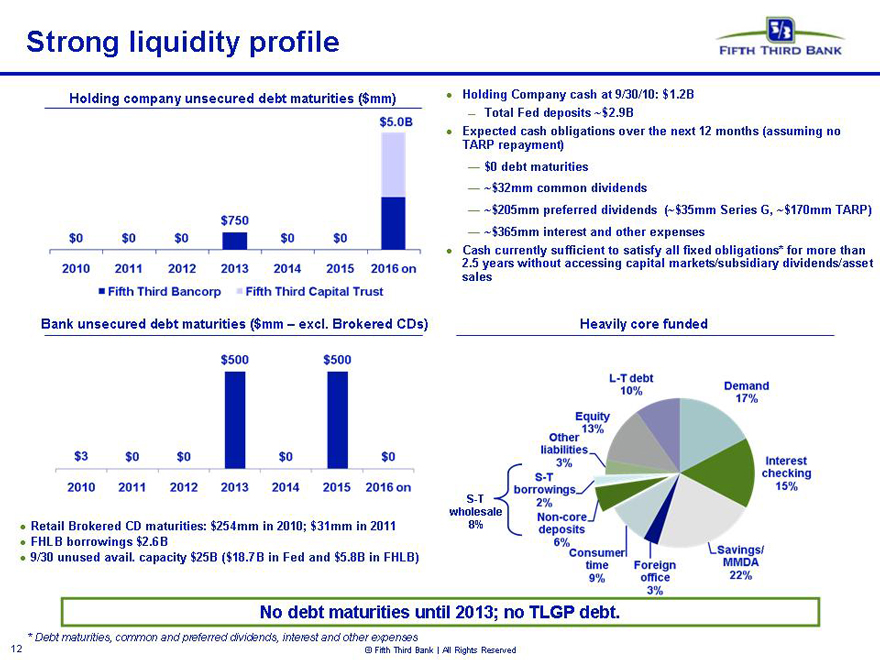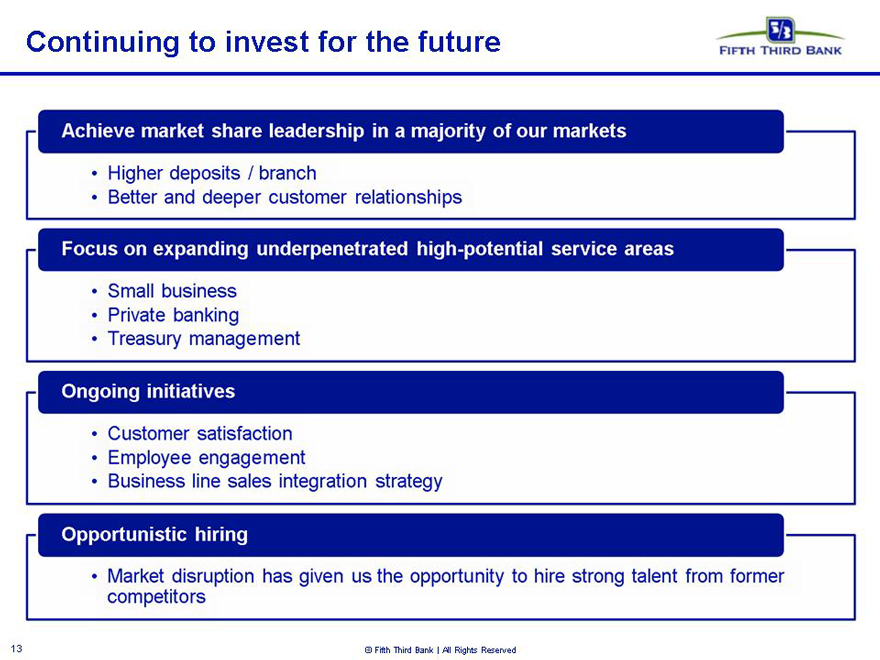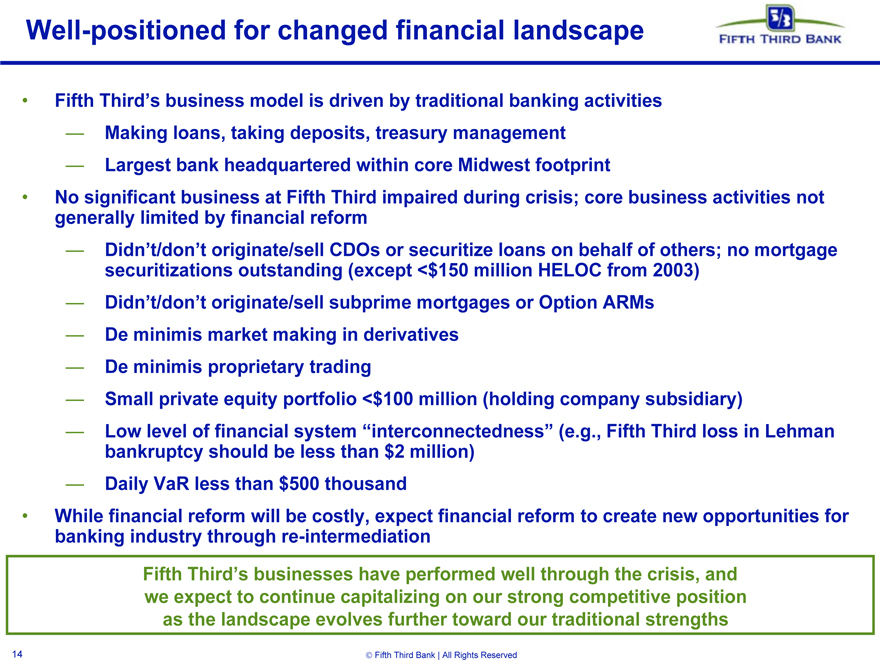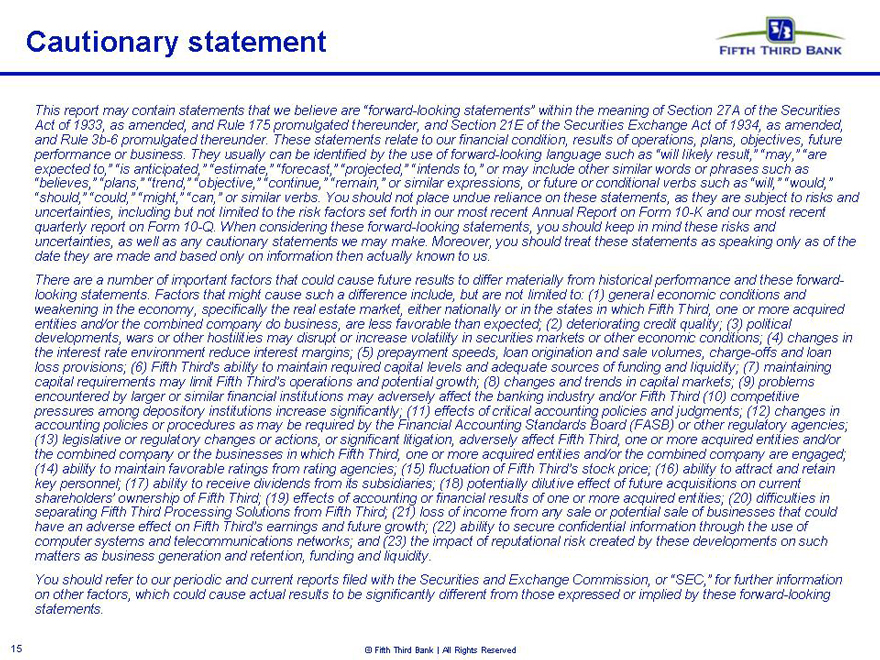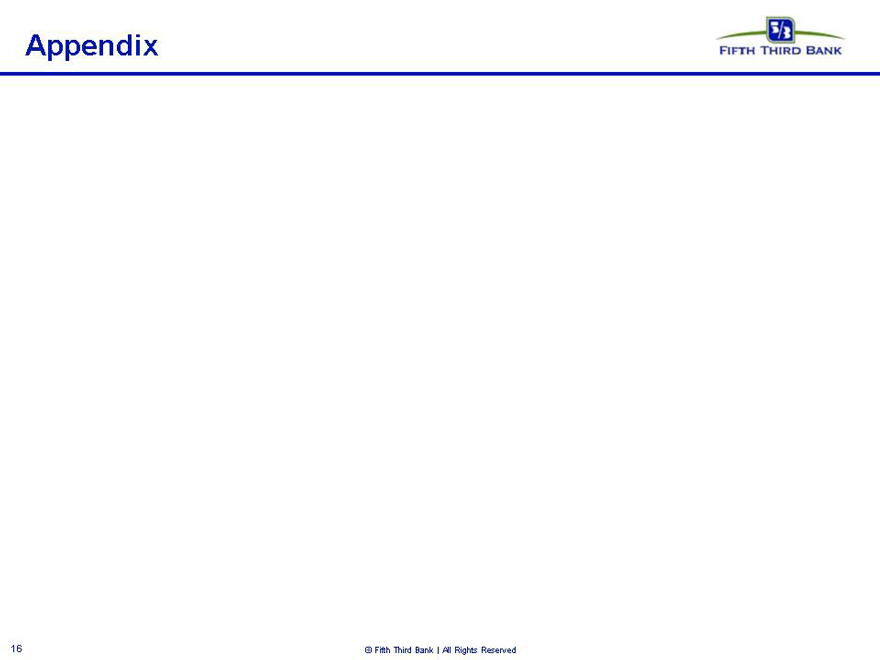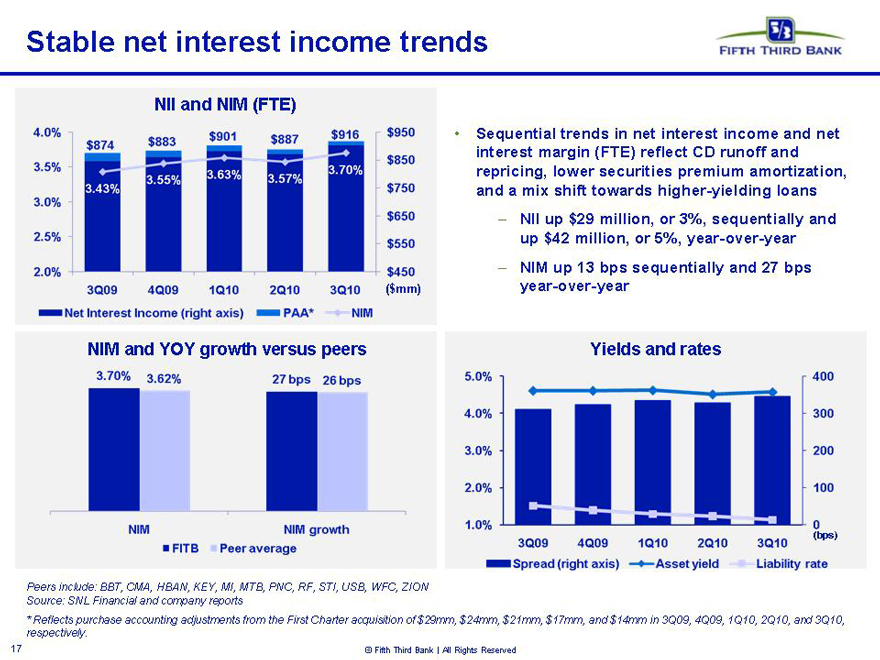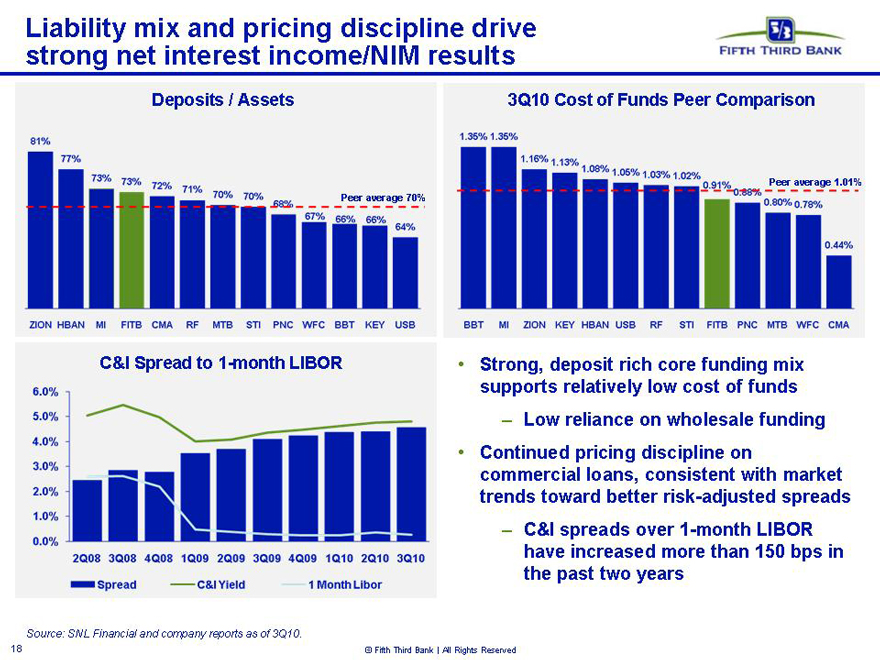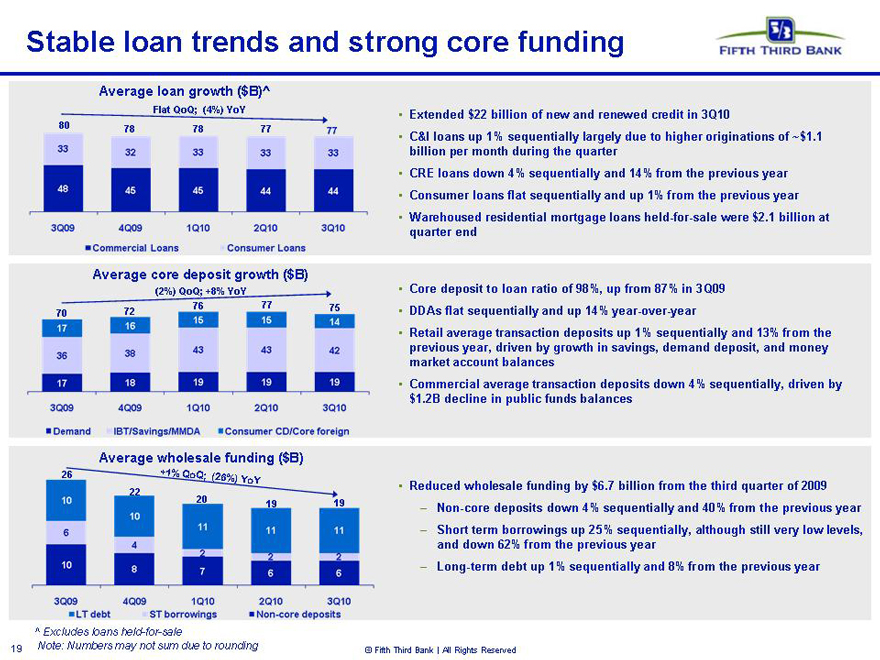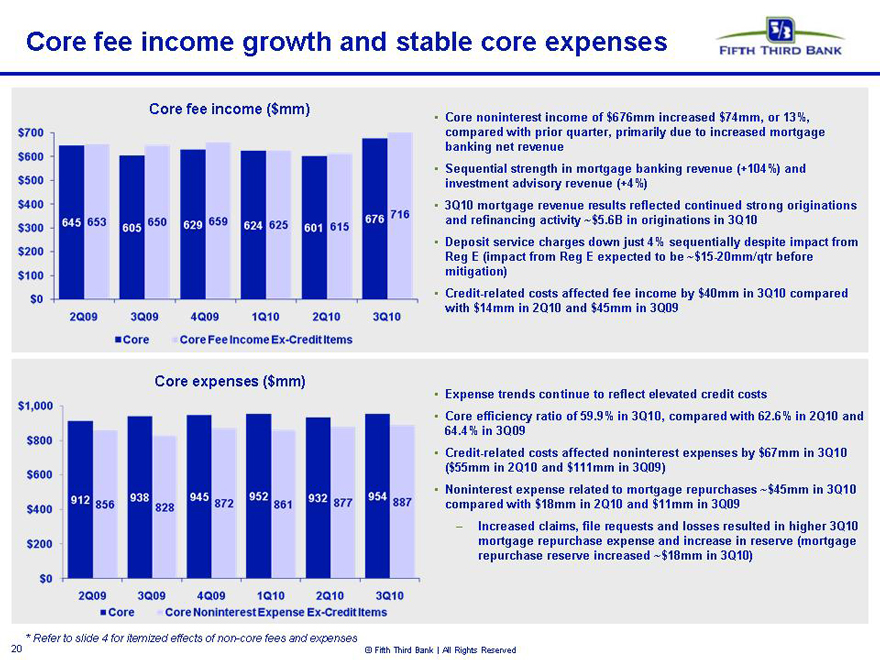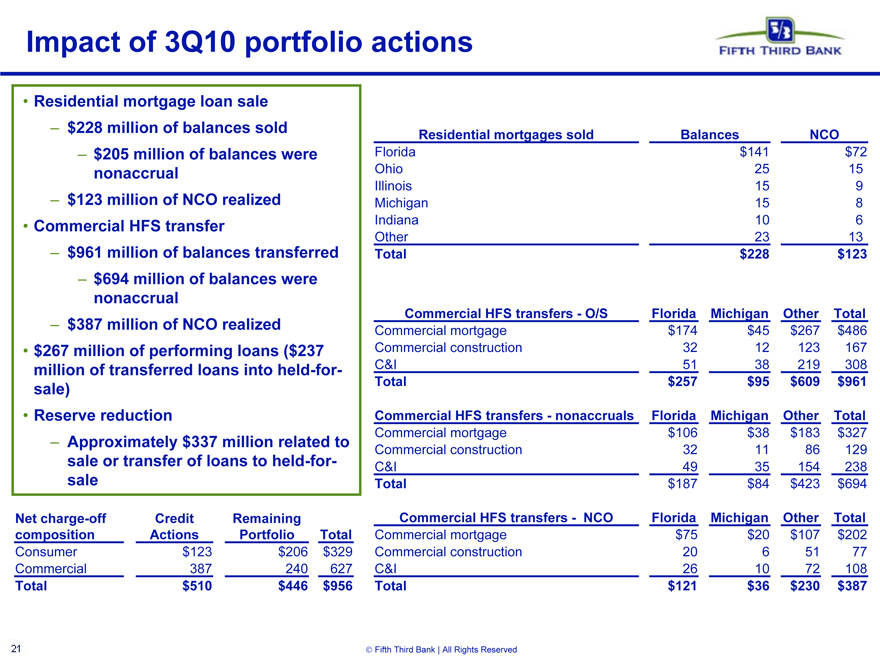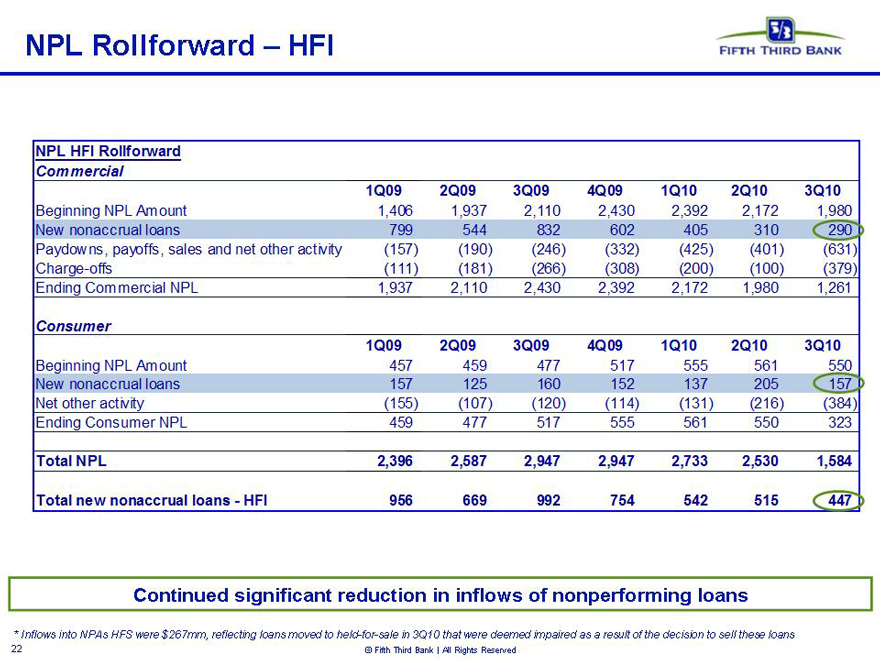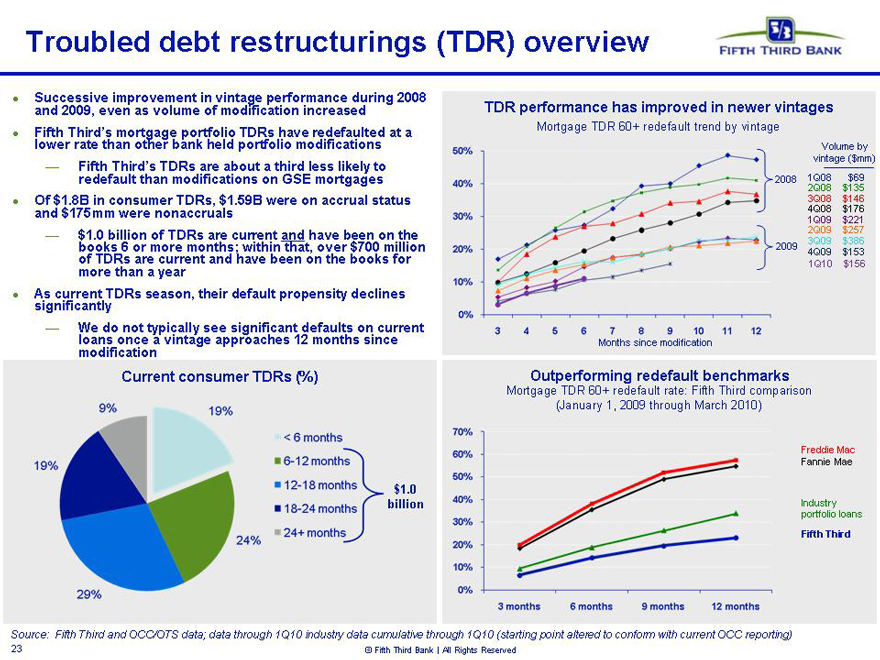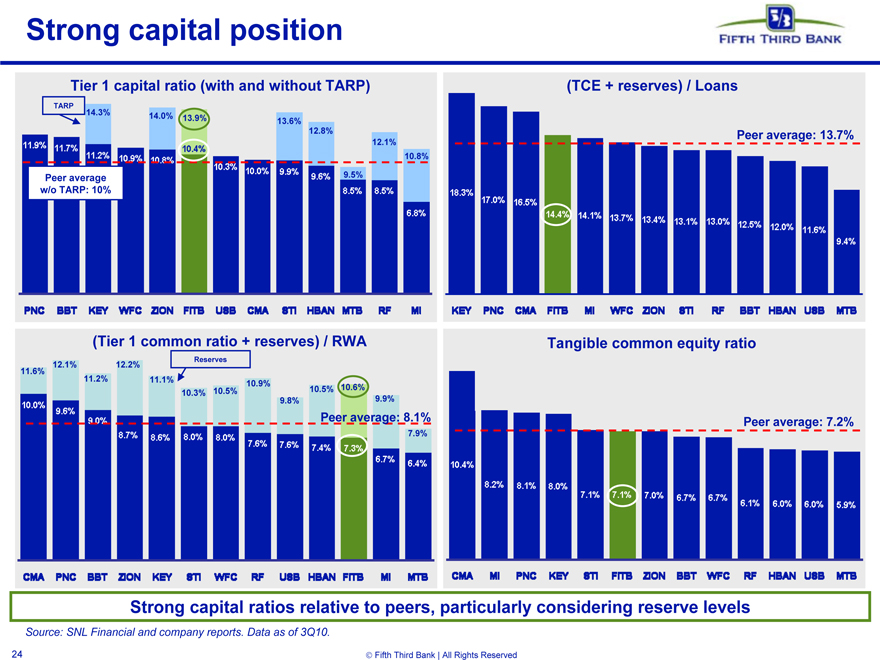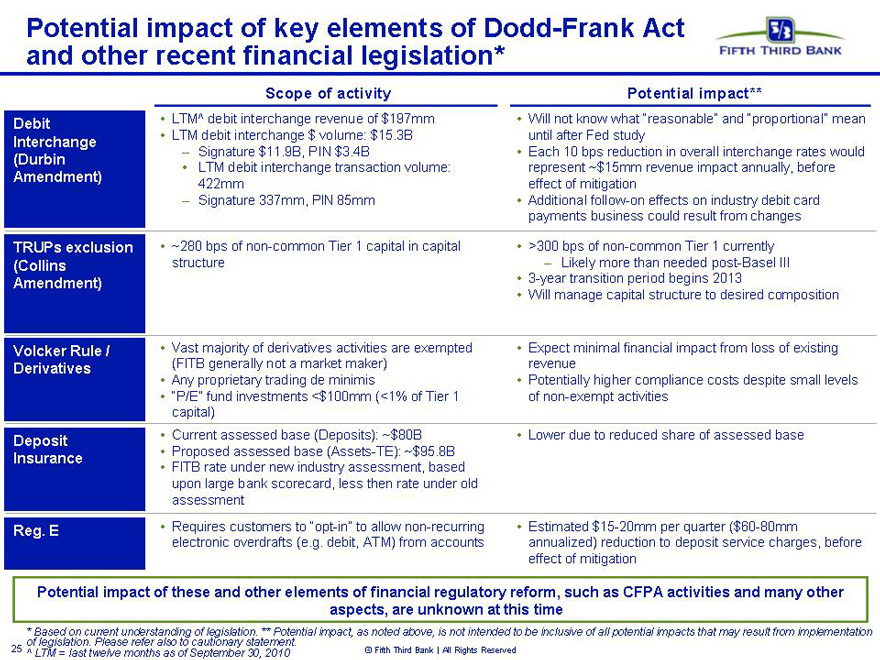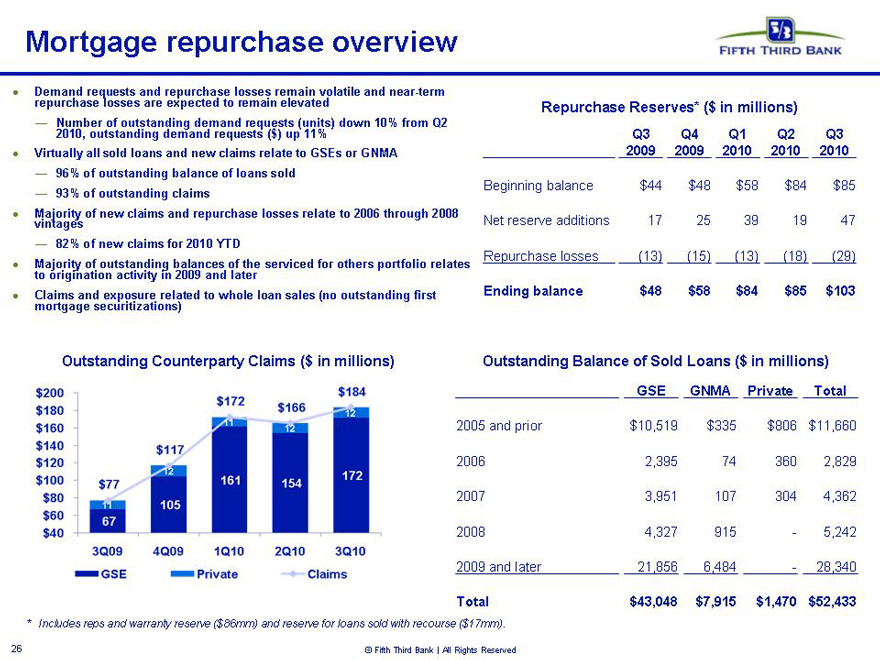Exhibit 99.1
Goldman Sachs
U.S. Financial Services Conference
Kevin T. Kabat
President & Chief Executive Officer
December 7, 2010
Please refer to earnings release dated October 21, 2010 and 10-K dated
November 8, 2010 for further information
3Q10 in review
Continued strong operating results
Net income available to common shareholders of $175mm, or $0.22 per diluted share
– Includes $127mm pre-tax net impact of BOLI settlement and 3Q10 credit actions described below
Return on average assets of 0.84%; return on average common equity of 6.8%
Pre-provision net revenue (PPNR)* of $760mm: $633mm excluding BOLI, driven by strong NII growth and higher fees reflecting mortgage results
Strong capital ratios: Tier 1 common 7.3%, Tier 1 ratio 13.9%, Total capital ratio 18.3%
3Q10 credit actions driving further improvement in credit trends
•Sale or transfer to held-for-sale of $1.2B in loans: $228mm of consumer loans and $961mm of commercial loans
•Net charge-offs $956mm: $510mm on credit actions, $446mm otherwise
•Compared with 2Q10, nonperforming assets (NPAs) declined 30% (flat before the effect of 3Q credit actions) and nonperforming loans (NPLs) declined 38% (down 2% before the effect of 3Q credit actions)
–Total delinquencies down 10% sequentially (lowest level since 1Q07)
•Provision expense of $457mm
–~$337mm reserve reductions related to credit actions, ~$162mm reserve reductions related to remainder of portfolio
•Loan loss allowance of 4.20%; coverage 153% of NPAs and 202% of NPLs
Actions driving progress
•Focusing on credit quality, portfolio management and loss mitigation strategies
•Executing on customer satisfaction initiatives and improving customer loyalty
•Enhancing breadth and profitability of offerings and relationships
•Becoming an employer of choice in the industry by continuing to enhance employee engagement
* Pre-provision net revenue: net interest income plus noninterest income minus noninterest expense
Fifth Third Bank | All Rights Reserved
2
Strong profitability results
Core PPNR / Average Assets (Annualized)*
USB 2.9%
WFC 2.8%
MTB 2.3%
FITB 2.2%
PNC 2.1%
BBT 2.1%
HBAN 1.9%
STI 1.7%
KEY 1.6%
CMA 1.4%
RF 1.3%
MI 1.3%
ZION 1.3%
ROAA
PNC 1.7%
USB 1.3%
MTB 1.1%
WFC 1.1%
KEY 1.0%
FITB 0.8%
HBAN 0.8%
BBT 0.6%
CMA 0.4%
STI 0.4%
ZION (0.4)%
RF (0.5)%
MI (1.1)%
Core PPNR/NCOs*
MTB 417%
PNC 226%
USB 213%
WFC 210% 185%
BBT 93%
CMA 142% 142%
FITB 66%
HBAN 136%
STI 106%
KEY 104% 86%
RF 60%
ZION 71%
MI 31%
•Strong PPNR profitability creates higher than average loss absorption capacity
•Profitability not dependent on reserve releases
•Return on assets higher than peer average
•Fourth quarter trends remain on track
–Expect 4Q10 ROA >1%; ROE ~10%
Source: SNL Financial and company reports. Data as of 3Q10.
* Core pre-tax pre-provision earnings excludes the following items: securities gains/losses, gains/losses from debt extinguishments, leveraged lease gains/losses, gains from asset sales, and other non-recurring items. Net charge-offs include and exclude net charge-offs related to loans sold or moved to held-for-sale during 3Q10 for FITB ($510mm), RF ($233mm), and BBT ($432mm)
Fifth Third Bank | All Rights Reserved
3
Pre-tax pre-provision earnings
Core PPNR trend
Adjusted PPNR +31%; Credit adjusted PPNR +28%
1Q09 2Q09 3Q09 4Q09 1Q10 2Q10 3Q10
Adjusted 483 564 539 562 569 552 634
Fee Income Credit Items 3 8 45 30 1 14 40
Noninterest Expense Credit Items 94 57 111 73 91 55 67
1Q09 2Q09 3Q09 4Q09 1Q10 2Q10 3Q10
Reported PPNR $511 $2,393 $844 $562 $568 $567 $760
Adjustments:
BOLI 54 - - - - - (127)
Gain on sale of Visa shares - - (244) - 9 - -
Gain from sale of processing interest - (1,764) 6 - - - -
Divested merchant and EFT revenue (155) (169) 2 - - - -
Class B Visa swap fair value adjustment - - - - - - -
Securities gains/losses 24 (5) (8) (2) (14) (8) (4)
Visa litigation reserve expense - - (73) - - - -
Other litigation reserve expense - - - 22 4 3 -
FTPS warrants + puts - - - (20) 2 (10) 5
Seasonal pension expense - - 10 - - - -
FDIC special assessment - 55 - - - - -
Divested merchant and EFT expense (est.) 49 54 2 - - - -
Core PPNR $483 $564 $539 $562 $569 $552 $634
Credit Related Items:
OREO write-downs, FV adjs, & G/L on loan sales 3 8 45 30 1 14 40
Problem asset work-out expenses 94 57 111 73 91 55 67
Credit adjusted PPNR $580 $630 $695 $665 $661 $621 $741
•Reported PPNR of $760 million up 34% from strong 2Q10 levels driven by strong net interest income growth, higher fees reflecting mortgage results and litigation settlement
•Adjusted PPNR of $634 million, due to adjustments totaling ($126) million, resulting in adjusted sequential and year-over-year increases of 15% and 18%, respectively
•Excluding the impact of credit-related adjustments ($107mm in 3Q10), PPNR up 19% versus 2Q10; up 7% versus 3Q09
•4Q10 PPNR ~$580mm range +/-
* Pre-provision net revenue (PPNR): net interest income plus noninterest income minus noninterest expense
© Fifth Third Bank | All Rights Reserved
4
Loans 30-89 days delinquent % vs. peers
3Q07 4Q07 1Q08 2Q08 3Q08 4Q08 1Q09 2Q09 3Q09 4Q09 1Q10 2Q10 3Q10
0.0%
0.5%
1.0%
1.5%
2.0%
2.5%
FITB
Peer Average
NPA ratio vs. peers
3Q07 4Q07 1Q08 2Q08 3Q08 4Q08 1Q09 2Q09 3Q09 4Q09 1Q10 2Q10 3Q10 4Q10
FITB
Peer Average
0.5%
1.5%
2.5%
3.5%
4.5%
4Q10 expect stable
Loans 90+ days delinquent % vs. peers
3Q07 4Q07 1Q08 2Q08 3Q08 4Q08 1Q09 2Q09 3Q09 4Q09 1Q10 2Q10 3Q10
FITB
Peer Average
0%
0.2%
0.4%
0.6%
0.8%
1.0%
1.2%
1.4%
1.6%
Net charge-off ratio vs. peers
3Q07
4Q07
1Q08
2Q08
3Q08
4Q08
1Q09
2Q09
3Q09
4Q09
1Q10
2Q10
3Q10
4Q10
FITB
Peer Average
3.8%
Before credit actions
(7.5%)* (HFS transfer)
5.0%
4Q10 expect below 2%
2.3%*
Before credit actions
0.0%
1.0%
2.0%
3.0%
4.0%
5.0%
FITB credit metrics were higher than peers but are now generally better than peers
Source: SNL and company reports. NPA and NCO ratios exclude loans held-for-sale and covered assets for peers where appropriate.
*4Q08 net charge-offs included $800mm in NCOs related to commercial loans moved to held-for-sale; 3Q10 net charge-offs included $510mm in NCOs related to loans sold or moved to held-for-sale.
Fifth Third Bank | All Rights Reserved
5
Non-performing loans
FITB NPL inflows (relative to loans) vs. peers
3.50%
3.00%
2.50%
Fifth Third’s non-performing loan inflows (relative to loans) were higher than peers throughout 2008. More recently, FITB inflows have been lower than peers and generally in the top quartile.
Peers include: BAC, BBT, C, CMA, HBAN, JPM, KEY, MI, MTB, PNC, RF, STI, USB, and WFC
1Q08
2Q08
3Q08
4Q08
1Q09
2Q09
3Q09
4Q09
1Q10
2Q10
3Q10
FITB
Non-performing loans improving with lower severity mix; benefit of sale/transfer
$3,500
$3,000
$2,500
$2,000
(37%) Q0Q; (46%) Y0Y
$1,500
$1,00
$500
$0
3Q49
4Q49
1Q10
2Q10
3Q10
Commercial
Consumer
2,430
2,392
2,172
1,980
1,261
323
$1.6B
$2.9B
$2.9B
$2.7B
$2.5B
517
555
561
550
New HFI non-performing loan flows ($mm)*
$1,00
$800
$600
$400
$200
$0
3Q09
4Q09 1Q10 2Q10 3Q10
$992
$832
$180
$152 $ 137 $205 $310 $405 $602 $754 $542 $510 $447 $310 $205 $447 $290 $157
total Commerical Consume
* Inflows into NPAs HFS were $237mm, reflecting performing loans moved to held-for-sale in 3Q10 that were deemed impaired as a result of the decision to sell these loans
* Fifth Third Bank | All Rights Reserved
6
Strong credit metrics compared with peers
Net Charge-off Ratio* (Annualized)
0.7%
1.3%
1.6%
1.7%
2.0%
2.1%
2.1%
2.3%
2.4%
2.4%
2.5%
2.7%
5.5%
Total Net Change offs
5.0%
3.5%
3.4%
MTB
CMA
PNC
BBT
HBAN
USB
WFC
FITB
STI
RF
ZION
KEY
MI
Peer average: 2.3%
HFI NPA Ratio
“Texas Ratio”
(HFI NPAs + Over 90s) / (Reserves + TCE)
Peer average: 3.8%
18%
21%
21%
25%
27%
28%
29%
35%
36%
38%
40%
43%
KEY CMA USB FITB PNC HBAN MTB BBT STI MI WFC RF ZION
Peer average: 30%
(HFI NPAs + Over 90s – Reserves) / TCE
2.0%
2.5%
2.7%
3.0%
3.2%
3.4%
3.8%
4.4%
4.5%
4.5%
4.5%
5.0%
5.7%
KEY CMA USB FITB PNC HBAN MTB BBT STI MI WFC RF ZION
Peer average: 9%
FITB HBAB USB KEY PNC CMA MTB BBT MI RF STI WFC ZIPN
10%
(4%)
(4%)
(3%)
5%
8%
11%
11%
15%
16%
18%
19%
19%
FITB credit metrics lower than peer average and represent position of relative strength
Source: SNL Financial and company reports.
* Includes and excludes net charge-offs related to loans sold or moved to held-for-sale during 3Q10 for FITB ($510mm), RF ($233mm), and BBT ($432mm).
* Fifth Third Bank | All Rights Reserved
7
Industry leading reserve levels
Reserves / Loans
4.2% 4.1% 3.8% 3.8% 3.6% 3.5% 3.5% 3.2% 2.8% 2.7% 2.6% 2.4% 1.8%
FITB ZION KEY RF HBAN MI PNC WFC USB STI BBT CMA MTB
Loan loss allowance provides significant additional loss absorption capacity to strong capital position
Reserves / NPLs
202% 177% 143% 136% 132% 108% 94% 89% 85% 85% 81% 80% 71%
FITB USB KEY HBAN BBT PNC RF MI WFC ZION MTB CMA STI
Industry-leading reserve coverage of problem loans
Reserves / NPAs
Peer average: 89%
153% 149% 125% 121% 92% 83% 79% 73% 72% 70% 69% 69% 61%
FITB USB KEY HBAN PNC RF BBT CMA ZION MI MTB WFC STI
Reserves / Net Charge-offs* (Annualized)
Lighter portion excludes charge-offs on loans sold or moved to held-for-sale
Peer average: 157%
243% 215% 183% 183% 181% 84% 164% 153% 106% 149% 75% 147% 138% 135% 113% 62%
MTB PNC CMA HBAN FITB ZION RF BBT WFC KEY USB STI MI
Reserve coverage strong relative to problem assets and losses
Source: SNL Financial and company reports Data. as of 3Q10 NPLs and NPAs exclude loans held-for-sale.
* Includes and excludes net charge-offs related to loans sold or moved to held-for-sale during 3Q10 for FITB ($510mm), RF ($233mm), and BBT ($432mm)
Fifth Third Bank | All Rights Reserved
8
Updated internally-specified stress analysis: Macroeconomic assumptions
Current Base Case Recession Depression
Economic Assumptions* 3Q2010 2011 2011 2011
Average Unemployment 9.6% 9.9% 11.3% 13.5% YoY GDP Growth 3.1% 4.1% 2.2% (2.0%) Yoy Change in Housing Prices (1.6%) (2.4%) (9.6%) (13.9%) Avg Effective Fed Funds 0.19% 0.22% 0.22% 0.13% Avg Capacity Utilization 74.7% 74.8% 72.0% 67.2% Avg Consumer Confidence 50.9 62.9 68.2 51.6 Avg YoY S&P 500 Index Growth 10.1% 11.2% 13.5% (9.5%)
Note: These internally-specified scenarios are from Moody’s Economy.com and do not reflect the supervisory-specified stress scenarios provided to 19 U.S. banks in November
Cumulative GDP Growth
5% 4% 3% 2% 1% 0% (1%) (2%) (3%) (4%) (5%)
4Q10 1Q11 2Q11 3Q11 4Q11
Base Case Recession Depression
Unemployment
16% 14% 12% 10% 8% 6% 4% 2% 0%
4Q10 1Q11 2Q11 3Q11 4Q11
Base Case Recession Depression
Cumulative HPI Growth (OFHEO)
0% (2%) (4%) (6%) (8%) (10%) (12%) (14%) (16%) (18%) (20%)
4Q10 1Q11 2Q11 3Q11 4Q11
Base Case Recession Depression
10 Year Treasury
5% 5% 4% 4% 3% 3% 2% 2% 1% 1% 0%
4Q10 1Q11 2Q11 3Q11 4Q11
Base Case Recession Depression
* Moody’s Economy.com as of November, 2010
Fifth Third Bank | All Rights Reserved
9
Updated internal stress analysis vs. SCAP scenarios
2009 SCAP scenarios vs. current loss expectations under internally-specified scenarios
$5,500 $5,000 $4,500 $4,000 $3,500 $3,000 $2,500 $2,000 $1,500 $1,000 $500 $0
Fifth Third capitalized under SCAP for this level of credit losses -plus surplus raised vs. required buffer -plus earnings outperformance
SCAP Adverse Scenario1 (Supervisory; Mar 2009)
$5.0B
$4.1B
Actual $2.7B
Included $800mm
related to 4Q08 credit actions
SCAP Baseline Scenario (Submitted; Mar 2009) $2.9B
Actual $2.6B
Includes $510mm related to 3Q10 credit actions
$2.8B
Act/Fcst ~$2.35B3
Internal stress evaluation; does not reflect Supervisory Stress Scenario under Revised Temporary Addendum to S.R. letter. 09-4
Internal Depression Case2 (4% probability)
Internal Recession Case2 (25% probability)
Internal Base Case2
2008 2009 2010 2011
Fifth Third’s realized credit losses have been significantly below its SCAP submitted baseline and more adverse scenarios
We expect 2010 losses to be lower than our original baseline scenario submission despite our 3Q10 actions that resulted in immediate charge-off recognition of $510mm
Stress scenarios as of November, 2010 from Moody’s Economy.com; incorporate further deterioration in credit market conditions, which is not currently expected
Realized credit losses have been significantly below SCAP submissions; expect further improvement reflecting anticipated likely economic conditions and previous credit actions
1 Red SCAP line represents more adverse scenario as adjusted by supervisors for additional assumed two-year losses. Supervisory estimates of total two-year losses under more adverse scenario were not allocated by period. Estimate allocates total two-year supervisory losses using the allocation under Fifth Third’s submission.
2 Moody’s Economy.com scenarios; macroeconomic scenarios and estimates as of November 2010 (probabilities assigned by Moody’s).
Fifth Third Bank | All Rights Reserved
3 including current 4Q10 outlook
10
Fifth Third capital position and goals
• Current capital position strong relative to peers, U.S. regulatory standards, and proposed “Basel III” standards
– Currently expect no material adjustments to Tier 1 common ratio under new rules
– Tier 1 common capital could increase under Basel proposed definitions (not assumed for capital planning)
• Basel III standards have begun to provide clarity on “future state” capital requirements
– U.S. regulators have expressed support for those standards (final U.S. rules are dependent on rule-making)
• On the basis of these standards, we have established a near-term Tier 1 common equity ratio target in the 8% range (3Q10 actual: 7.34%)
– Would provide 100 basis points cushion over the 7% fully phased-in Basel III buffered minimum for Tier 1 common that is to apply globally by 2019¹ (minimum of 4.5% and capital conservation buffer of 2.5%)
– We would expect internal capital generation (i.e., earnings less dividends) to cause Tier 1 common equity to continue to increase in the intermediate term, due to current limitations on the industry’s ability to manage capital levels (e.g., lower than normal dividend payout ratios, share repurchases, etc.)
• Federal Reserve has recently established a 5% Tier 1 common minimum (post-stress) under supervisory-specified stress scenario²
– For our own evaluation of results under internally-specified severe stress scenarios outlined on pp. 10-11, we target the maintenance of a Tier 1 common ratio well above the supervisory reference minimum
• TARP repayment: TARP capital is not needed by Fifth Third; improved economic environment, establishment of new Basel III capital standards, and strong results provide foundation for discussions with Federal Reserve
– We have significant excess capital relative to prevailing U.S. capital standards, excluding TARP
– Post-TARP repayment, we would intend for all capital ratios to immediately meet or exceed both fully phased-in Basel III buffered minimum capital ratios as well as our own internal targets
– Repayment of TARP including terms subject to Federal Reserve approval
1 Basel III minimum capital ratios are to be phased-in over a number of years. “Buffered minimums” include capital conservation buffers that are also to be phased in following phase-in of minimum ratios. A 3% leverage ratio has been proposed under Basel III but not adopted. The denominator of this ratio adopted by U.S. regulators may not be the same as that used for the calculation of the current leverage ratio. See http://www.bis.org/press/p100912.pdf for more information.
2 There is no current Tier 1 common well-capitalized minimum ratio under current U.S. capital standards. Supervisory reference minimum of 5.0% Tier 1 common capital is to be utilized for evaluation of forward-looking results under supervisory stress scenario.
Tier 1 common ratio reflects current U.S. capital definitions. See http://www.federalreserve.gov/newsevents/press/bcreg/bcreg20101117b1.pdf for more.
Fifth Third Bank | All Rights Reserved
11
Strong liquidity profile
Holding company unsecured debt maturities ($mm)
$0 $0 $0 $750 $0 $0 $5.0B
2010 2011 2012 2013 2014 2015 2016 on
Fifth Third Bancorp
Fifth Third Capital Trust
Bank unsecured debt maturities ($mm – excl. Brokered. CDs)
$3 $0 $0 $500 $500 $0 $0.
2010 2011 2012 2013 2014 2015 2016 on.
Retail Brokered CD maturities: $254mm in 2010; $31mm in 2011 FHLB borrowings $2.6B
9/30 unused avail. capacity $25B ($18.7B in Fed and $5.8B in FHLB)
Holding Company cash at 9/30/10: $1.2B
– Total Fed deposits ~$2.9B
Expected cash obligations over the next 12 months (assuming no TARP repayment)
– $0 debt maturities
– ~$32mm common dividends
– ~$205mm preferred dividends (~$35mm Series G, ~$170mm TARP)
– ~$365mm interest and other expenses
Cash currently sufficient to satisfy all fixed obligations* for more than
2.5 years without accessing capital markets/subsidiary dividends/asset sales
Heavily core funded
L-T debt 10% Equity 13% Other liabilities 3%
S-T wholesale 8% S-T borrowings 2% Non-core deposits 6% Consumer time 9%
Foreign office 3% Savings MMDA 22% Interest checking 15% Demand 17%
No debt maturities until 2013; no TLGP debt.
*Debt maturities, common and preferred dividends, interest and other expenses
Fifth Third Bank | All Rights Reserved
12
Continuing to invest for the future
Achieve market share leadership in a majority of our markets
Higher deposits/branch
Better and deeper customer relationships
Focus on expanding under penetrated high-potential service areas
Small business
Private banking
Treasury management
Ongoing initiatives
Customer satisfaction
Employee engagement
Business line sale integration strategy
Opportunistic hiring
Market disruption has given us the opportunity to hire strong talent from former competitors
Fifth Third Bank | All Rights Reserved
13
Well-positioned for changed financial landscape
Fifth Third’s business model is driven by traditional banking activities
— Making loans, taking deposits, treasury management
— Largest bank headquartered within core Midwest footprint
No significant business at Fifth Third impaired during crisis; core business activities not generally limited by financial reform
— Didn’t/don’t originate/sell CDOs or securitize loans on behalf of others; no mortgage securitizations outstanding (except <$150 million HELOC from 2003)
— Didn’t/don’t originate/sell subprime mortgages or Option ARMs
— De minimis market making in derivatives
— De minimis proprietary trading
— Small private equity portfolio <$100 million (holding company subsidiary)
— Low level of financial system “interconnectedness” (e.g., Fifth Third loss in Lehman bankruptcy should be less than $2 million)
— Daily VaR less than $500 thousand
While financial reform will be costly, expect financial reform to create new opportunities for banking industry through re-intermediation
Fifth Third’s businesses have performed well through the crisis, and we expect to continue capitalizing on our strong competitive position as the landscape evolves further toward our traditional strengths
Fifth Third Bank | All Rights Reserved
14
Cautionary statement
This report may contain statements that we believe are “forward-looking statements” within the meaning of Section 27A of the Securities Act of 1933, as amended, and Rule 175 promulgated thereunder, and Section 21E of the Securities Exchange Act of 1934, as amended, and Rule 3b-6 promulgated thereunder. These statements relate to our financial condition, results of operations, plans, objectives, future performance or business. They usually can be identified by the use of forward-looking language such as “will likely result,” “may,” “are expected to,” “is anticipated,” “estimate,” “forecast,” “projected,” “intends to,” or may include other similar words or phrases such as “believes,” “plans,” “trend,” “objective,” “continue,” “remain,” or similar expressions, or future or conditional verbs such as “will” “would,” “should,” “could,” “might,” “can,” or similar verbs. You should not place undue reliance on these statements, as they are subject to risks and uncertainties, including but not limited to the risk factors set forth in our most recent Annual Report on Form 10-K and our most recent quarterly report on Form 10-Q. When considering these forward-looking statements, you should keep in mind these risks and uncertainties, as well as any cautionary statements we may make. Moreover, you should treat these statements as speaking only as of the date they are made and based only on information then actually known to us.
There are a number of important factors that could cause future results to differ materially from historical performance and these forward-looking statements. Factors that might cause such a difference include, but are not limited to: (1) general economic conditions and weakening in the economy, specifically the real estate market, either nationally or in the states in which Fifth Third, one or more acquired entities and/or the combined company do business, are less favorable than expected; (2) deteriorating credit quality; (3) political developments, wars or other hostilities may disrupt or increase volatility in securities markets or other economic conditions; (4) changes in the interest rate environment reduce interest margins; (5) prepayment speeds, loan origination and sale volumes, charge-offs and loan loss provisions; (6) Fifth Third’s ability to maintain required capital levels and adequate sources of funding and liquidity; (7) maintaining capital requirements may limit Fifth Third’s operations and potential growth; (8) changes and trends in capital markets; (9) problems encountered by larger or similar financial institutions may adversely affect the banking industry and/or Fifth Third (10) competitive pressures among depository institutions increase significantly; (11) effects of critical accounting policies and judgments; (12) changes in accounting policies or procedures as may be required by the Financial Accounting Standards Board (FASB) or other regulatory agencies; (13) legislative or regulatory changes or actions, or significant litigation, adversely affect Fifth Third, one or more acquired entities and/or the combined company or the businesses in which Fifth Third, one or more acquired entities and/or the combined company are engaged; (14) ability to maintain favorable ratings from rating agencies; (15) fluctuation of Fifth Third’s stock price; (16) ability to attract and retain key personnel; (17) ability to receive dividends from its subsidiaries; (18) potentially dilutive effect of future acquisitions on current shareholders’ ownership of Fifth Third; (19) effects of accounting or financial results of one or more acquired entities; (20) difficulties in separating Fifth Third Processing Solutions from Fifth Third; (21) loss of income from any sale or potential sale of businesses that could have an adverse effect on Fifth Third’s earnings and future growth; (22) ability to secure confidential information through the use of computer systems and telecommunications networks; and (23) the impact of reputational risk created by these developments on such matters as business generation and retention, funding and liquidity.
You should refer to our periodic and current reports filed with the Securities and Exchange Commission, or “SEC,” for further information on other factors, which could cause actual results to be significantly different from those expressed or implied by these forward-looking statements.
Fifth Third Bank | All Rights Reserved
15
Appendix
Fifth Third Bank | All Rights Reserved
16
Stable net interest income trends
NII and NIM (FTE)
4.0% 3.5% 3.0% 2.5% 2.0%
$874 $883 $901 $887 $916
3Q09 4Q09 1Q10 2Q10 3Q10
$950 $850 $750 $650 $550 $450 ($mm)
3.43% 3.55% 3.63% 3.57% 3.70%
Net interest Income (right axis) PAA* NIM
Sequential trends in net interest income and net
interest margin (FTE) reflect CD runoff and
repricing, lower securities premium amortization,
and a mix shift towards higher-yielding loans
– NII up $29 million, or 3%, sequentially and
up $42 million, or 5%, year-over-year
– NIM up 13 bps sequentially and 27 bps
year-over-year
NIM and YOY growth versus peers
3.70% 3.62% 27 bps 26 bps
NIM NIM growth
FITB Peer average
Yields and rates
5.0% 4.0% 3.0% 2.0% 1.0%
3Q09 4Q09 1Q10 2Q10 3Q10
400 300 200 100 0 (bps)
Spread (right axis) Asset yield Liability rate
Peers include: BBT, CMA, HBAN, KEY, MI, MTB, PNC, RF, STI, USB, WFC, ZION
Source: SNL Financial and company reports
* Reflects purchase accounting adjustments from the First Charter acquisition of $29mm, $24mm, $21mm, $17mm, and $14mm in 3Q09, 4Q09, 1Q10, 2Q10, and 3Q10,
respectively.
Fifth Third Bank | All Rights Reserved
17
Liability mix and pricing discipline drive
strong net interest income/NIM results
Deposits / Assets
Peer average 70%
81% 77% 73% 73% 72% 71% 70% 70% 68% 67% 66% 66% 64%
ZION HBAN MI FITB CMA RF MTB STI PNC WFC BBT KEY USB
3Q10 Cost of Funds Peer Comparison
1.35% 1.35% 1.16% 1.13% 1.08% 1.05% 1.03% 1.02% 0.91% 0.88% 0.80% 0.78% 0.44%
Peer average 1.01%
BBT MI ZION KEY HBAN USB RF STI FITB PNC MTB WFC CMA
C&I Spread to 1-month LIBOR
6.0% 5.0% 4.0% 3.0% 2.0% 1.0% 0.0%
2Q08 3Q08 4Q08 1Q09 2Q09 3Q09 4Q09 1Q10 2Q10 3Q10
Spread C&I Yield 1 Month Libor
Strong, deposit rich core funding mix supports relatively low cost of funds
– Low reliance on wholesale funding
Continued pricing discipline on commercial loans, consistent with market trends toward better risk-adjusted spreads
– C&I spreads over 1-month LIBOR have increased more than 150 bps in the past two years
Source: SNL Financial and company reports as of 3Q10.
Fifth Third Bank | All Rights Reserved
18
Stable loan trends and strong core funding
Average loan growth ($B)^
Flat QoQ; (4%) YoY
80 78 78 77 77
33 32 33 33 33
48 45 45 44 44
3Q09 4Q09 1Q10 2Q10 3Q10
Commercial Loans Consumer Loans
Extended $22 billion of new and renewed credit in 3Q10
C&I loans up 1% sequentially largely due to higher originations of ~$1.1
billion per month during the quarter
CRE loans down 4% sequentially and 14% from the previous year
Consumer loans flat sequentially and up 1% from the previous year
Warehoused residential mortgage loans held-for-sale were $2.1 billion at
quarter end
Average core deposit growth ($B)
(2%) QoQ; +8% YoY
70 72 76 77 75
17 16 15 15 14
36 38 43 43 42
17 18 19 19 19
3Q09 4Q09 1Q10 2Q10 3Q10
Demand IBT/Savings/MMDA Consumer CD/Core foreign
Core deposit to loan ratio of 98%, up from 87% in 3Q09
DDAs flat sequentially and up 14% year-over-year
Retail average transaction deposits up 1% sequentially and 13% from the
previous year, driven by growth in savings, demand deposit, and money
market account balances
Commercial average transaction deposits down 4% sequentially, driven by
$1.2B decline in public funds balances
Average wholesale funding ($B)
+1% QoQ; (26%) YoY
26 22 20 19 19
10 10 11 11 11
6 4 2 2 2
10 8 7 6 6
3Q09 4Q09 1Q10 2Q10 3Q10
LT debt ST borrowings Non-core deposits
Reduced wholesale funding by $6.7 billion from the third quarter of 2009
– Non-core deposits down 4% sequentially and 40% from the previous year
– Short term borrowings up 25% sequentially, although still very low levels,
and down 62% from the previous year
– Long-term debt up 1% sequentially and 8% from the previous year
^ Excludes loans held-for-sale
Note: Numbers may not sum due to rounding
Fifth Third Bank | All Rights Reserved
19
Core fee income growth and stable core expenses
Core fee income ($mm)
$700 $600 $500 $400 $300 $200 $100 $0
653 650 659 625 615 716
645 605 629 624 601 676
2Q09 3Q09 4Q09 1Q10 2Q10 3Q10
Core Core Fee Income Ex-Credit Items
Core noninterest income of $676mm increased $74mm, or 13%,
compared with prior quarter, primarily due to increased mortgage
banking net revenue
Sequential strength in mortgage banking revenue (+104%) and
investment advisory revenue (+4%)
3Q10 mortgage revenue results reflected continued strong originations
and refinancing activity ~$5.6B in originations in 3Q10
Deposit service charges down just 4% sequentially despite impact from
Reg E (impact from Reg E expected to be ~$15-20mm/qtr before
mitigation)
Credit-related costs affected fee income by $40mm in 3Q10 compared
with $14mm in 2Q10 and $45mm in 3Q09
Core expenses ($mm)
$1000 $800 $600 $400 $200 $0
912 938 945 952 932 954
856 828 872 861 877 887
2Q09 3Q09 4Q09 1Q10 2Q10 3Q10
Core Core Noninterest Expense Ex-Credit Items
Expense trends continue to reflect elevated credit costs
Core efficiency ratio of 59.9% in 3Q10, compared with 62.6% in 2Q10 and
64.4% in 3Q09
Credit-related costs affected noninterest expenses by $67mm in 3Q10
($55mm in 2Q10 and $111mm in 3Q09)
Noninterest expense related to mortgage repurchases ~$45mm in 3Q10
compared with $18mm in 2Q10 and $11mm in 3Q09
– Increased claims, file requests and losses resulted in higher 3Q10
mortgage repurchase expense and increase in reserve (mortgage
repurchase reserve increased ~$18mm in 3Q10)
Refer to slide 4 for itemized effects of non-core fees and expenses
Fifth Third Bank | All Rights Reserved
20
Impact of 3Q10 portfolio actions
Residential mortgage loan sale
– $228 million of balances sold
– $205 million of balances were
nonaccrual
– $123 million of NCO realized
Commercial HFS transfer
– $961 million of balances transferred
– $694 million of balances were
nonaccrual
– $387 million of NCO realized
• $267 million of performing loans
($237 million of transferred loans
into held-for-sale)
Reserve reduction
– Approximately $337 million related to
sale or transfer of loans to held-for-
sale
Net charge-off composition Credit Actions Remaining Portfolio Total
Consumer $123 $206 $329
Commercial 387 240 627
Total $510 $446 $956
Residential mortgages sold Balances NCO
Florida $141 $72
Ohio 25 15
Illinois 15 9
Michigan 15 8
Indiana 10 6
Other 23 13
Total $228 $123
Commercial HFS transfers - O/S Florida Michigan Other Total
Commercial mortgage $174 $45 $267 $486
Commercial construction 32 12 123 167
C&I 51 38 219 308
Total $257 $95 $609 $961
Commercial HFS transfers - nonaccruals Florida Michigan Other Total
Commercial mortgage $106 $38 $183 $327
Commercial construction 32 11 86 129
C&I 49 35 154 238
Total $187 $84 $423 $694
Commercial HFS transfers - NCO Florida Michigan Other Total
Commercial mortgage $75 $20 $107 $202
Commercial construction 20 6 51 77
C&I 26 10 72 108
Total $121 $36 $230 $387
Fifth Third Bank | All Rights Reserved
21
NPL Rollforward – HFI
NPL HFI Rollforward
Commercial
1Q09 2Q09 3Q09 4Q09 1Q10 2Q10 3Q10
Beginning NPL Amount 1,406 1,937 2,110 2,430 2,392 2,172 1,980 New nonaccrual loans 799 544 832 602 405 310 290 Paydowns, payoffs, sales and net other activity (157) (190) (246) (332) (425) (401) (631) Charge-offs (111) (181) (266) (308) (200) (100) (379) Ending Commercial NPL 1,937 2,110 2,430 2,392 2,172 1,980 1,261
Consumer
1Q09 2Q09 3Q09 4Q09 1Q10 2Q10 3Q10
Beginning NPL Amount 457 459 477 517 555 561 550 New nonaccrual loans 157 125 160 152 137 205 157 Net other activity (155) (107) (120) (114) (131) (216) (384) Ending Consumer NPL 459 477 517 555 561 550 323
Total NPL 2,396 2,587 2,947 2,947 2,733 2,530 1,584
Total new nonaccrual loans—HFI 956 669 992 754 542 515 447
Continued significant reduction in inflows of nonperforming loans
* inflows into NPAs HFS were $267mm, reflecting loans moved to held-for-sale in 3Q10 that were deemed impaired as a result of the decision to sell these loans
Fifth Third Bank | All Rights Reserved
22
Troubled debt restructurings overview (TDR)
Successive and 2009, even improvement as volume in of vintage modification performance increased during 2008 Fifth Third’s mortgage portfolio TDRs have redefaulted at a lower rate than other bank held portfolio modifications
— Fifth redefault Third’s than TDRs modifications are about on a third GSE less mortgages likely to Of $0.8B and in consumer $175mm were nonaccruals TDRs $1.59B, were on accrual status
— $0.1 billion of TDRs are current and have been on the books 6 or more months; within that, over $700 million of more TDRs than are a current year and have been on the books for As current TDRs season, their default propensity declines significantly
— We do not typically see significant defaults on current loans modification once a vintage approaches 12 months since
Current consumer TDRs (%)
$1.0 billion
19% 9% 19% 24% 29%
<6 months 6-12 months 12-18 months 18-24 months 24+ months
TDR performance has improved in newer vintages
Mortgage TDR 60+ redefault trend by vintage
2008
2009
Volume by vintage ($mm)
Months since modification
50% 40% 30% 20% 10% 0% 3 4 5 6 7 8 9 10 11 12
Outperforming redefault benchmarks
Mortgage TDR 60+ redefault rate: Fifth Third comparison (January 2009 1, through March 2010)
Freddie Mac Fannie Mae
Industry portfolio loans
Fifth Third
70% 60% 50% 40% 30% 20% 10% 0% 3 months 6 months 9 months 12 months
Source: Fifth Third and OCC/OTS data; data through 1Q10 industry data cumulative through 1Q10 (starting point altered to conform with current OCC reporting)
Fifth Third Bank | All Rights Reserved
23
Strong capital position
Tier 1 capital ratio (with and without TARP)
Peer average w/o TARP: 10%
TARP 14.3% 14.0% 13.9% 13.6% 12.8% 12.1% 10.8%
11.9% 11.7% 11.2% 10.9% 10.8% 10.4% 10.3% 10.0% 9.9% 9.6% 8.5% 8.5% 6.8%
PNC BBT KEY WFC ZION FITB UBS CMA STI HBAN MTB RF MI
common ratio + reserves) / RWA
Reserves
12.1% 11.6% 12.2% 11.2% 11.1% 10.3% 10.5% 10.5% 9.8% 10.6% 9.9%
Peer average: 8.1%
7.9% 10.0% 9.6% 9.0% 8.7% 8.6% 8.0% 8.0% 7.6% 7.6% 7.4% 7.3% 6.7% 6.4%
KEY PNC CMA FITB MI WFC ZION STI RF BBT HBAN UBS MTB
(TCE + reserves) / Loans
Peer average: 13.7%
18.3% 17.0% 16.5% 14.4% 14.1% 13.7% 13.4% 13.1% 13.0% 12.5% 12.0% 11.6% 9.4%
CMA PNC BBT ZION KEY STI WFC RF USB HBAN MTB MI MTB
Tangible common equity ratio
Peer average: 7.2%
10.4% 8.2% 8.1% 8.0% 7.1% 7.1% 7.0% 6.7% 6.7% 6.1% 6.0% 6.0% 5.9%
CMA MI PNC KEY STI FITB ZION BBT WFC RF HBAN USB MTB
Strong capital ratios relative to peers, particularly considering reserve levels
Source: SNL Financial and company reports. Data as of 3Q10.
© Fifth Third Bank | All Rights Reserved
24
Potential impact of key elements of Dodd-Frank Act and other recent financial legislation*
Debit Interchange (Durbin Amendment)
TRUPs exclusion (Collins Amendment)
Volcker Rule / Derivatives
Deposit Insurance
Reg.E
Scope of activity
LTM^ debit interchange revenue of $197mm LTM debit interchange $ volume: $15.3B
– Signature$11.9B, PIN $3.4B
• LTM debit interchange transaction volume: 422mm
– Signature 337mm, PIN 85mm
~280 bps of non-common Tier 1 capital in capital structure
Vast majority of derivatives activities are exempted (FITB generally not a market maker) Any proprietary trading de minimis “P/E” fund investments <$100mm(<1% of Tier 1 capital) Current assessed base (Deposits): ~ $80B Proposed assessed base (Assets-TE): ~ $ 95.8B FITB rate under new industry assessment, based upon large bank scorecard, less then rate under old assessment Requires customers to “opt-in”to allow non-recurring electronic overdrafts (e.g debit, ATM) from accounts
Potential impact**
Will not know what “reasonable” and “proportional” mean until after Fed study Each 10 bps reduction in overall interchange rates would represent ~ $15mm revenue impact annually, before effect of mitigation Additional follow-on effects on industry debit card payments business could result from changes
>300 bps of non-common Tier 1 currently
– Likely more than needed post-Basel III
3-year transition period begins 2013
Will manage capital structure to desired composition
Expect minimal financial impact from loss of existing revenue Potentially higher compliance costs despite small levels of non-exempt activities
Lower due to reduced share of assessed base
Estimated $15-20mm per quarter ($60-80mm annualized) reduction to deposit service charges, before effect of mitigation
Potential impact of these and other elements of financial regulatory reform, such as CFPA activities and many other aspects, are unknown at this time
Based of legislation on current Please. understanding refer also to cautionary of legislation statement . Potential** . impact, as noted above, is not intended to be inclusive of all potential impacts that may result from implementation
^ LTM = last twelve months as of September 13, 2010 Fifth Third Bank | All Rights Reserved
25
Mortgage repurchase overview
Demand repurchase requests losses and are repurchase expected to losses remain remain elevated volatile and near-term
— Number 2010, outstandin of outstanding g demand demand requests requests ($up) 11% down(units) 10% from Q2 Virtually all sold loans and new claims relate to GSEs or GNMA
— 96% of outstanding balance of loans sold
— 93% of outstanding claims
Majority of new claims and repurchase losses relate to 2006 through 2008 vintages
— 82% of new claims for 2010 YTD
Majority to origination of outstanding activity in balances 2009 and of later the serviced for others portfolio relates Claims mortgage and securitizations) exposure related to whole loan sales outstanding(no first
Outstanding Counterparty Claims ( in$ millions)
Repurchase Reserves* ( in$ millions)
Q3 Q4 Q1 Q2 Q3 20102010201020092009
Beginning balance 85$84$ Net reserve additions 17 25 39 4719 Repurchase losses (13) (15) (13) (18) (29)
Ending balance 103$85$
Outstanding Balance of Sold Loans ( in$ millions)
$200 $180 $160 $140 $120 $100 $80 $60 $40
$77 $117 $172 $168 $184
11 12 11 12 12
67 105 161 154 172
3Q09 4Q09 1Q10 2Q10 3Q10
GSE Private Claims
GSE GNMA Private Total
2005 and prior 11,660$806$335$10,519$
2006 2,829360742,395
2007 4,3623041073,951
2008 9154,327—5,242
2009 and later 6,48421,856—28,340
Total $52,433 $1,470 $7,915 $43,048
* Includes reps and warranty reserve ($86mm) and reserve for loans sold with recourse ($17mm).
Fifth Third Bank | All Rights Reserved
26
